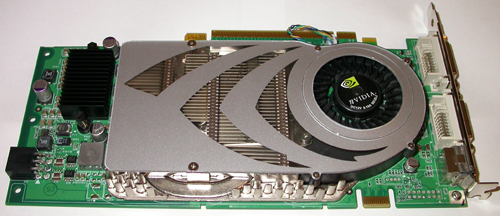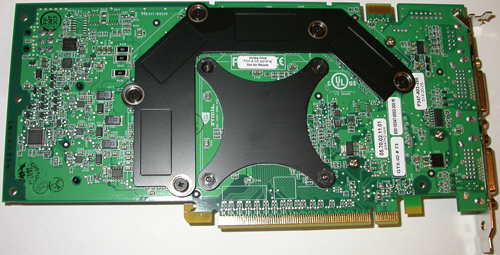NVIDIA's GeForce 7800 GTX Hits The Ground Running
by Derek Wilson on June 22, 2005 9:00 AM EST- Posted in
- GPUs
The Test, Card, and High Resolution
Before we get down to the performance tests, let's look at our test system.ASUS nForce 4 A8N-SLI Deluxe Motherboard
AMD FX-55
1GB DDR3200 2:2:2:8
120GB Seagate 7200.7 HD
OCZ PowerStream 600W PSU
The card this time around is a single slot solution. With the process shrink to 110nm an insignificant increase in clock speed, NVIDIA has produced a chip that runs at lower power and temperature than NV40. At the same time, the increase in parallelism has served to boost performance.
Layout of the card is relatively similar to the 6800 Ultra, but there are a few differences. We've still got 2 DVI slots (both single link), but the solder point for the silicon image TMDS chip for dual-link DVI is either missing or moved. We will certainly be interested in seeing a workstation version of this part.
Here's a quick recap and summary of the G70 and GeForce 7800 GTX:
302M transistors
Over 300mm^2
110 nm TSMC fabrication process
Single Slot HSF
430MHz Core clock
600MHz GDDR3 256MB/256-bit
8 vertex shader units
24 pixel shader units
16 ROP units
2 DVI and one HDTV / VIVO connection
PCI- Express (demand for an AGP part will be determined and addressed if necessary)
~100W Power
350W Power Supply Recommended (500W for SLI)
So what is all the fuss about? Here's a look at the NVIDIA GeForce 7800 GTX card:


Why high res?
It is important to remember that we tested at resolutions of 1600x1200 and higher because lower resolutions are CPU limited without AA and AF enabled. In many cases the GeForce 7800 GTX don't show much difference in performance with and without antialiasing at lower resolutions. This kind of data doesn't give us much useful information about the card. We have truly reached another plateau in graphics performance with this part: pushing the card to the max is all but necessary in order to understand its performance characteristics.










127 Comments
View All Comments
VIAN - Wednesday, June 22, 2005 - link
"NVIDIA sees texture bandwidth as outweighing color and z bandwidth in the not too distant future." That was a quote from the article after saying that Nvidia was focusing less on Memory Bandwidth.Do these two statements not match or is there something I'm not aware of.
obeseotron - Wednesday, June 22, 2005 - link
These benchmarks are pretty clearly rushed out and wrong, or at least improperly attributed to the wrong hardware. SLI 6800 show up faster than SLI 7800's in many benchmarks, in some cases much more than doubling single 6800 scores. I understand NDAs suck with the limited amount of time to produce a review, but I'd rather it have not been posted until the afternoon than ignore the benchmarks section.IronChefMoto - Wednesday, June 22, 2005 - link
#28 -- Mlittl3 can't pronounce Penske or terran properly, and he's giving out grammar advice? Sad. ;)SDA - Wednesday, June 22, 2005 - link
QUESTIONOkay, allcaps=obnoxious. But I do have a question. How was system power consumption measured? That is, was the draw of the computer at the wall measured, or was the draw on the PSU measured? In other words, did you measure how much power the PSU drew from the wall or how much power the components drew from the PSU?
Aikouka - Wednesday, June 22, 2005 - link
Wow, I'm simply amazed. I said to someone as soon as I saw this "Wow, now I feel bad that I just bought a 6800GT ... but at least they won't be available for 1 or 2 months." Then I look and see that retailers already have them! I was shocked to say the least.RyDogg1 - Wednesday, June 22, 2005 - link
But my question was "who," was buying them. I'm a hardware goon as much as the next guy, but everyone knows that in 6-12 months, the next gen is out and price is lower on these. I mean the benches are presenting comparisons with cards that according to the article are close to a year old. Obviously some sucker lays down the cash because the "premium," price is way too high for a common consumer.Maybe this one of the factors that will lead to the Xbox360/PS3 becoming the new gaming standard as opposed to the Video Card market pushing the envelope.
geekfool - Wednesday, June 22, 2005 - link
What no Crossfire benchies? I guess they didn't wany Nvidia to loose on their big launch day.Lonyo - Wednesday, June 22, 2005 - link
The initial 6800U's cost lots because of price gouging.They were in very limited supply, so people hiked up the prices.
The MSRP of these cards is $600, and they are available.
MSRP of the 6800U's was $500, the sellers then inflated prices.
Lifted - Wednesday, June 22, 2005 - link
#24: In the Wolfenstein graph they obviously reversed the 7800 GTX SLI with the Radeon.They only reveresed a couple of labels here and there, chill out. It's still VERY OBVIOUS which card is which just by looking at the performance!
WAKE UP SLEEPY HEADS.
mlittl3 - Wednesday, June 22, 2005 - link
Derek,I know this article must have been rushed out but it needs EXTREME proofreading. As many have said in the other comments above, the results need to be carefully gone over to get the right numbers in the right place.
There is no way that the ATI card can go from just under 75 fps at 1600x1200 to over 100 fps at 2048x1535 in Enemy Territory.
Also, the Final Words heading is part of the paragraph text instead of a bold heading above it.
There are other grammatical errors too but those aren't as important as the erroneous data. Plus, a little analysis of each of the benchmark results for each game would be nice but not necessary.
Please go over each graph and make sure the numbers are right.